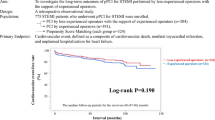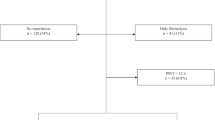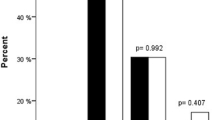
Overview
- Focuses entirely on primary PCI based on latest evidence and guidelines
- Covers key topics from pre-hospital, emergency department and interventional catheter laboratory point-of-view
- Chapters are structured in a step-by-step approach covering the topics as per the patient’s journey from symptom onset to diagnosis to treatment
Buy print copy
Tax calculation will be finalised at checkout
About this book
This book is open access under a CC BY 4.0 license.
This quick-reference handbook offers a concise and practical review of key aspects of the treatment of ST-segment elevation myocardial infarction (STEMI) in the era of primary percutaneous coronary intervention (PPCI). In the context of STEMI, PPCI is the preferred mode of emergency revascularization. Access to PPCI is rapidly increasing and is now routinely practiced in both general and specialist hospitals and there has been a recent emphasis on developing STEMI networks to enhance and expedite the referral pathway. This coupled with concurrent developments to enhance the safety and efficacy of the PPCI procedure has heralded an era where STEMI interventions are increasingly considered an important subspecialty within interventional cardiology.
Written by leading cardiologists who have been instrumental in the adoption of PPCI in their respective institutions, the book provides junior and senior cardiologists alike with insightful and thought-provoking tips and tricks to enhance the success of PPCI procedures, which may in turn translate into direct improvements in outcomes. The book is also relevant for healthcare providers and emergency department physicians.
Similar content being viewed by others

Keywords
Table of contents (23 chapters)
-
Front Matter
Editors and Affiliations
About the editors
Dr. Timothy Watson is a board certified interventional cardiologist with a keen interest in novel technologies and research. He qualified at the University of London and completed his internship and residency in various hospitals in London and across the West Midlands region. After becoming a member of the Royal College of Physicians of London, he joined a clinical research training programme where he led a study investigating mechanisms of blood clot formation in atrial fibrillation, a common irregular heartbeat which can increase the risk of stroke. For this work, he has been awarded a Doctor of Medicine (MD) degree from the University of Birmingham. Dr. Watson trained in general and interventional cardiology, primarily at Addenbrooke's and Papworth Hospitals in Cambridge. He has subsequently undertaken a fellowship in interventional and structural cardiology at the renowned Green Lane Cardiovascular Unit in Auckland, New Zealand, where he has beeninvolved in various first-in-human studies using exciting and novel technologies, some of which are now being introduced into clinical mainstream practice. He has worked as a consultant (interventional) cardiologist in New Zealand, Malaysia and in Singapore. In addition to his work as a clinical cardiologist, he continues to undertake various research projects as an investigator and maintains active research collaborations with the University of Auckland.
Dr. Paul Ong graduated from the University of Cambridge. He has been a member of the Royal College of Physicians since 1996 and has been a fellow of Royal College of Physicians (FRCP) in London and fellow of the European Society of Cardiology (FESC) since 2008. He completed his early medical training in some of the most prestigious London teaching hospitals. Dr. Ong completed his cardiology specialist training in NW Thames, gaining dual accreditation in cardiology and general medicine. He was awarded the Certificate of Completion of Specialist Training (CCST) in both specialties in 2004. He was a NHS consultant interventional cardiologist and cath lab director at the Lister Hospital, Herts and honorary consultant cardiologist at Royal Brompton and Harefield NHS Trust until 2008. He is currently a senior consultant and Head of the Interventional Cardiology service at the Department of Cardiology at Tan Tock Seng Hospital in Singapore. Dr. Ong has lectured and presented at numerous international meetings and has travelled to various parts of Asia to proctor and support new cardiac units. He is the organising chairman of the Asia Primary Angioplasty Congress and course co-director for Asia PCR and the Asian Champion for the Stent Save a Life initiative.
Dr. James E. Tcheng, MD is a professor of Medicine, at the Department of Medicine Cardiology division and professor of Community and Family Medicine, Department of Community and Family Medicine at the Duke University School of Medicine, and also the Chief Medical Information Officer for the Duke Heart Network. Dr. Tcheng is a practicing interventional cardiologist and member of the faculty of the Duke Clinical Research Institute (DCRI) and the Duke Center for Health Informatics (DCHI). He is Director of the Duke Cardiovascular Databank and Director of Performance Improvement for the Duke Heart Center. He is faculty of the Medical Device Epidemiology Network (MDEpiNet) Coordinating Center of the DCRI. In addition, he is chair of the Informatics and Health IT Task Force of the American College of Cardiology, a member of the ACC National Cardiovascular Data Registry Management Board, and the ACC/AHA Task Force on Clinical Data Standards. His clinical interests focus on the management of coronary artery disease, including percutaneous coronary intervention (angioplasty), stent implantation, laser angioplasty, and the treatment of chronic total coronary occlusions. His clinical research has focused on antiplatelet and anticoagulant therapies for cardiovascular disease. Dr. Tcheng received his MD degree from the Johns Hopkins University School of Medicine in Baltimore, Maryland and has completed his residency in medicine at Barnes Hospital / Washington University in St. Louis, Missouri. He completed his fellowship training in cardiology at Duke University and has been a member of the Duke faculty of since 1988.
Bibliographic Information
Book Title: Primary Angioplasty
Book Subtitle: A Practical Guide
Editors: Timothy J Watson, Paul JL Ong, James E Tcheng
DOI: https://doi.org/10.1007/978-981-13-1114-7
Publisher: Springer Singapore
eBook Packages: Medicine, Medicine (R0)
Copyright Information: The Editor(s) (if applicable) and The Author(s) 2018
Hardcover ISBN: 978-981-13-1113-0Published: 25 July 2018
Softcover ISBN: 978-981-13-4570-8Published: 02 January 2019
eBook ISBN: 978-981-13-1114-7Published: 13 July 2018
Edition Number: 1
Number of Pages: XIV, 338
Number of Illustrations: 54 b/w illustrations, 80 illustrations in colour
Topics: Cardiology



